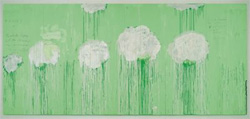Twombly made his Peony Blossom Paintings in Gaeta during the late fall of 2006 and the early winter of 2007. The group comprises six 18-foot-long horizontal multipanel paintings executed in thin acrylic with wax crayon and pencil, the crowning achievement of which is Untitled, 2001. For this work, Twombly coated the six wood panels with an all-over yellowish light green wash. He then rendered five rosettes in a darker saturated green that dripped copiously down the canvas. Twombly overpainted these blossoms with white, again allowing trails of drips beneath each blossom. The effect, overtly sumptuous and lush, is one of melting, dissolving flowers, which seem to be flourishing and withering at the same time.
The peony’s emblematic associations are rich. Like the chrysanthemum, it is an ancient symbol of aesthetic contemplation commonly associated with Japanese art, most especially Edo-period screen painting. (The six panels of each Peony Blossom Painting echo the six-panel format and proportion of the most popular Japanese folding screens.) The turn to Japonisme is further underscored by Twombly’s five discrete inscriptions, which cite rough translations and fragments by two revered Japanese haiku masters. On the sixth panel, Twombly quoted Takarai Kikaku, whose poem was inspired by the 14-century samurai Kusunoki Masashige:
AH! The Peonies
For which
Kusonoki
Took off his Armour
Presumably the beauty of nature, epitomized here by the wild peony, inspired a momentary pacifism in the warrior. Overcome by reverie, he turned away from battle in order to abandon himself fully to pleasure. In Twombly’s inscription, the initial r in the word armour is smaller than the other letters and was thus likely inserted by the artist as a revision or made to appear as an intentional afterthought. This perhaps intentional pun on the terms amour/armour further conflates the themes of love and violence that shape Kusunoki’s story.
Cy Twombly. Untitled, 2007. © Cy Twombly. Courtesy Gagosian Gallery.
Cy Twombly. Untitled, 2007. Private Collection. © Cy Twombly. Courtesy Gagosian Gallery.


